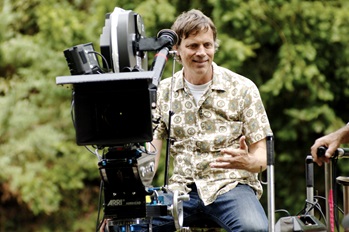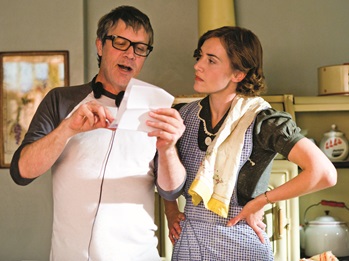BY AMY DAWES
 LAID-BACK: Haynes says independent financing has guaranteed
LAID-BACK: Haynes says independent financing has guaranteed
his freedom as opposed to working with a studio that controls
the end product.
For nearly 25 years, Todd Haynes has been American independent film's restless innovator. From Superstar, the 1987 underground classic in which he told the Karen Carpenter story with Barbie dolls, to Poison, the homoerotic Jean Genet-inspired triptych that won the Sundance Grand Jury Prize in 1991, and I'm Not There, his 2007 experimental inquiry into the many identities of Bob Dylan, Haynes has been a shape-shifter, compelled to defy expectations and conventional thinking at nearly every turn.
The white-hot media reaction to Poison, for example, turned him into a figurehead for what was then dubbed the "New Queer Cinema," and had him fielding calls from top producers. But rather than take a studio assignment, he spent years seeking independent financing for his 1995 feature Safe, a quietly explosive suburban drama starring Julianne Moore as a housewife who finds herself physically sickened by the toxic materials of her upscale lifestyle. It drew praise from critics, and his indie star rose again. Then when his visually sumptuous Douglas Sirk homage Far from Heaven (2002), also with Moore, landed four Oscar nominations, he could have cashed in. Instead, he transplanted himself from New York to Portland, Ore., and on the cross-country drive hit upon the idea of building a movie inspired by the Dylan songs that were the soundtrack for his journey.
So it's not entirely surprising that the project that has consumed Haynes for the past two years didn't play in movie theaters at all, but in America's living rooms, courtesy of HBO. It's an adaptation of the 1941 James M. Cain novel Mildred Pierce, told in the form of a five-part miniseries.
Haynes' take on Mildred completely eschews the noir style of the 1945 Michael Curtiz film starring Joan Crawford. Instead, it's a naturalistic, socially observant drama about a middle-class housewife in suburban Glendale, Calif., who ventures into the demeaning world of Depression-era blue-collar work to support her two daughters after her unemployed husband clears out.
The correlation to the economic woes of today was very much on Haynes' mind. "It's so much about the slippery slope of middle-class aspirations, and how things can easily go wrong—and that's something I didn't remember from the original film," he says. "Curtiz's version is an exquisite piece of Hollywood noir craftsmanship, and I would never have considered remaking that film."
Haynes says he drew inspiration from 1970sera films such as Chinatown and The Godfather that took a revisionist approach to genre pictures. "In the '70s, genre movies were getting re-examined by younger filmmakers who were bringing a more contemporary, nuanced style to the storytelling," notes Haynes. "I wanted to honor the bigger-than-life elements of Cain's novel, but also bring out some of the human elements that were missing in the original production."
He also made the decision to shoot on 16 mm film, working again with Ed Lachman, his cinematographer on I'm Not There and Far from Heaven. "Ed was a little nervous about depth of field and getting the best negative information on 16 mm, but he was pretty easily persuaded," says Haynes. "The financiers were thrilled because it was cheaper. I liked the idea that it's a classic format that we all studied in the old days, and one that kids don't use much anymore when they're learning their craft. But mostly, it was an intervention against how fast and fine-grained lenses and film stocks have become."
 FAST FOOD: Haynes, working with Kate Winslet, had to adjust to a
FAST FOOD: Haynes, working with Kate Winslet, had to adjust to a
breakneck television schedule for Mildred Pierce. Postproduction
was the most challenging.(Credit: Andrew Schwarz/HBO)
Haynes' commitment to naturalism meant shooting on location and using natural light as often as possible. This presented a challenge, given that the story is set in Los Angeles and Winslet needed to remain close to home in Manhattan during the 16-week shoot. So it was a break to find The Gables, a 1930s bungalow neighborhood on Long Island that suitably resembled the story's prewar Glendale environs, especially after citrus and palm trees were trucked in from Florida. Undeveloped stretches of beach on Long Island stood in for the coastline between Los Angeles and Santa Barbara—convincingly evoking the golden California light.
Working with people he trusted and had developed a shorthand with, including production designer Mark Friedberg, helped ease the pressure of adapting to a television schedule. "We all came from an extremely attentive, perfectionist background, and we didn't do it any differently on this—we just had to do it faster," laughs Haynes. "So it was great to have them all suffering alongside me, saying, 'Are they serious, man? This is ridiculous!' The sheer number of pages we were expected to shoot in a day—every day—made this a bizarre new experience for all of us."
Postproduction on the miniseries presented the greatest learning curve for the film-schooled crew. "At a certain point, you have all five episodes in various points of post, and it's quite dizzying," says Haynes. Editing was done around the clock, in shifts, and the best Haynes could do was to supervise. "I was just dancing between the two editing rooms, trying to keep on top of every new cut and the notes that came in. You're doing the rough cut on one, and another one is going in for special effects and color timing." Furthermore, early episodes were locked and out of his hands while the others were still under way—meaning that decisions made later in the process could not be applied to the picture as a whole.
Although he grew up in Encino with an intense interest in movies since he saw Mary Poppins at the age of 3, Haynes skipped film school to study art and semiotics at Brown University—a choice distinctly reflected in the conceptualist approach to his work. "I've always been interested in how meaning is constructed, and how cultural cues are embedded in it," he explains, "and particularly in representations of gender or sexuality." For instance, his 1998 film Velvet Goldmine explored how glam rockers such as David Bowie and his contemporaries in the '70s tantalized teenagers with the possibility of a boundary-blurring, androgynous sexuality.
After college, Haynes moved to New York where he and classmate Christine Vachon set up a nonprofit organization, Apparatus Productions, to support independent film initiatives. Even then, he says, "I saw myself more as a grant-seeking artist than a filmmaker." In fact, it was a modest grant from the National Endowment for the Arts for Poison that set off a conservative backlash after the boldly transgressive film gained notoriety at Sundance.
Most significant, though, has been Haynes' lasting bond with Vachon, who has produced all of his features and heads her own New York-based company, Killer Films. He credits their partnership with making his adventurous career possible. "I would have just given up trying to finance films as difficult on paper as Safe, or Far from Heaven, or I'm Not There, and it was her dogged refusal to ever give up that made the difference."
Independent financing, he notes, "guaranteed our freedom, as opposed to working with a single studio that has power over the end product." On the other hand, he says, "working with HBO on Mildred, I've felt liberated from those battles and preoccupations."
Despite a marathon process he describes as "hyper-focused" and "so much more intense than any film I've been a part of," Haynes isn't second-guessing his foray into television. "Television has an impact on our lives and the way we see the world that's as meaningful, if not more so, than film, because it reaches us in our domestic, private lives, and it's an interaction that takes place across a span of time," he says. "So I find it an important place to direct my imagination."
His appreciation for the small screen corresponds with concern about the risk-averse direction of the movie business. "It's been upsetting to watch Hollywood raking in more money than ever, but dispersing it less and less to a range of genres and filmmakers. To me, that's the death knell for the medium," he says. "In the past, it was always understood that the successful movies would pay for the smaller, riskier films to get made." Still, given the resurgence of business at Sundance this year, he's guardedly optimistic. "To hear that, there may be hope on the horizon—that's very encouraging."